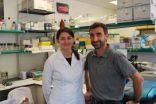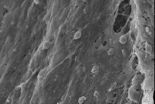(Press-News.org) Bread wheat (Triticum aestivum L.) is the most widely cultivated cereal crop in the world and provides 20 percent of the food calories consumed by humans. A polyploid species, hexaploid bread wheat contains six duplicated copies of its genome and is more than five times larger than the human genome. This makes genome research in wheat particularly difficult.
Dr. Klaus Mayer, Head of the Research Unit Plant Genome and Systems Biology at HMGU, in collaboration with his colleagues Matthias Pfeifer, Dr. Karl Kugler and Manuel Spannagl, succeeded in gaining insights into complex gene-regulatory interactions: for example, how genes can be transcribed at different stages of grain development. "Our studies help us to understand how a polyploid genome is regulated and orchestrated. It revealed that for different purposes different sub-genomes are favored and used. This will have impact on future breeding, agricultural cultivation and industrial properties of bread wheat," Mayer says.
Understanding as a basis for breeding
The highly specific intra- and inter-chromosomal activities of bread wheat enable it to adapt to the environment in many different possible ways. "The better we understand the organization, function and evolution of the large polyploid genome, the more easily we can identify the genes that are important for breeding," explains Mayer. "This will make it possible to breed the most suitable plant for different locations."
Long evolutionary history – many opportunities for development
The scientists can now trace a common ancestor of the wheat types "A" and "B" back to about seven million years. From this another third type ("D") evolved one to two million years later. "We have discovered that the present-day bread wheat genome is the result from a series of polyploidisation and hybridization events during the evolution of wheat. That is why we must understand it as a multilevel phylogenetic mosaic," explains Mayer.
"The newly gained insights into the biology of the bread wheat genome will enable us to isolate genes faster and speed up the development of genetic markers for breeding. These are the building blocks that will enable us to successfully meet the challenge of satisfying the world's growing demand for food at a time of stagnating yields, plant diseases and climate change," Mayer says.
INFORMATION:
Further research findings relating to the wheat genome: Major breakthrough in deciphering bread wheat's genetic code.
Further Information
*If more than two sets of chromosomes are present, this is referred to as a polyploid genome
Original publications:
International Wheat Genome Sequencing Consortium/ Mayer et al.(2014), A chromosome-based draft sequence of the hexaploid bread wheat genome, Science, doi: 10.1126/science.1251788
Link to publication: http://www.sciencemag.org/content/345/6194/1251788.abstract
Marcussen, T. et al (2014), Ancient hybridizations among the ancestral genomes of bread wheat, Science, doi: 10.1126/science.1250092
Link to publication: http://www.sciencemag.org/content/345/6194/1250092.abstract
Pfeifer, M. et al. (2014), Genome interplay in the grain transcriptome of hexaploid bread wheat, Science, doi: 10.1126/science.1250091
Link to publication: http://www.sciencemag.org/content/345/6194/1250091.abstract
Choulet, F. et al. 2014), Structural and Functional Partitioning of Bread Wheat Chromosome 3B, Science, doi: 10.1126/science.1249721
Link to publication: http://www.sciencemag.org/content/345/6194/1249721.abstract
Our daily bread
New insights into the bread wheat genome and its significance for the global food supply
2014-07-21
ELSE PRESS RELEASES FROM THIS DATE:
Described novel regulator of a protein inactive in over 50 percent of human tumors
2014-07-21
Researchers at the Bellvitge Biomedical Research Institute (IDIBELL) and the University of Barcelona have discovered the interaction between HERC2 proteins with another protein called p53 that is inactivated in more than half of human tumors. The study results were published in the Journal of Biological Chemistry.
Regulation of the activity of p53 by HERC2
The team of José Luis Rosa, at the growth factors and cell differentiation research group at IDIBELL studies the molecular mechanisms of HERC family proteins. These proteins are ubiquitin ligases that regulate the ...
Potential new flu drugs target immune response, not virus
2014-07-21
The seriousness of disease often results from the strength of immune response, rather than with the virus, itself. Turning down that response, rather than attacking the virus, might be a better way to reduce that severity, says Juliet Morrison of the University of Washington, Seattle. She and her collaborators have now taken the first step in doing just that for the H7N9 influenza, and their work has already led to identification of six potential therapeutics for this highly virulent strain. The research is published ahead of print in the Journal of Virology.
"We set ...
More than glitter
2014-07-21
A special class of tiny gold particles can easily slip through cell membranes, making them good candidates to deliver drugs directly to target cells.
A new study from MIT materials scientists reveals that these nanoparticles enter cells by taking advantage of a route normally used in vesicle-vesicle fusion, a crucial process that allows signal transmission between neurons. In the July 21 issue of Nature Communications, the researchers describe in detail the mechanism by which these nanoparticles are able to fuse with a membrane.
The findings suggest possible strategies ...
Mammals metabolize some pesticides to limit their biomagnification
2014-07-21
The concentrations of many historically used, and now widely banned, pesticides and other toxic chemicals—called legacy contaminants—can become magnified in an animal that eats contaminated food; however, a new Environmental Toxicology & Chemistry study has found that Arctic mammals metabolize some currently used pesticides, preventing such 'biomagnification.'
Researchers who studied the vegetation-caribou-wolf food chain in the Bathurst region of Canada say that currently use pesticides enter the food chain and become concentrated in vegetation, but the evidence shows ...
Examining the causes of a devastating debris flow
2014-07-21
Storm-triggered landslides cause loss of life, property damage, and landscape alterations. For instance, the remnants of Hurricane Camille in 1969 caused 109 deaths in central Virginia, after 600 mm of rain fell in mountainous terrain in 6 hours. More recently, on 8 August 2010, a rainstorm-induced landslide devastated the Chinese county of Zhouqu, causing more than 1000 deaths. A new modeling study by Ren (Geophysical Research Letters) examines the multiple factors, both natural and human caused, that came together to produce this event. The triad of storm-triggered landslides ...
New research links bad diet to loss of smell
2014-07-21
TALLAHASSEE, Fla. — Could stuffing yourself full of high-fat foods cause you to lose your sense of smell?
A new study from Florida State University neuroscientists says so, and it has researchers taking a closer look at how our diets could impact a whole range of human functions that were not traditionally considered when examining the impact of obesity.
"This opens up a lot of possibilities for obesity research," said Florida State University post-doctoral researcher Nicolas Thiebaud, who led the study examining how high-fat foods impacted smell.
Thiebaud led the ...
Study provides insights into birds' migration routes
2014-07-21
By tracking hybrids between songbird species, investigators have found that migration routes are under genetic control and could be preventing interbreeding. The research, which is published in Ecology Letters, was conducted using geolocators that, like GPS, record the position of a bird and allow its long distance movement to be tracked.
Compared with their parents, hybrids exhibited increased variability in their migratory routes: some used intermediate routes across less suitable areas, while others used the same routes as one parental group on fall migration and the ...
Motoneuron-like cell transplantation and GDNF delivery for repair of SCI
2014-07-21
Adipose-derived stem cells-transdifferentiated motoneurons after transplantation can integrate in the host cord. However, cell survival has been restricted by a lack of ideal environment for nerve cell growth. Taki Tiraihi, Shefa Neuroscience Research Center at Khatam Al-Anbia Hospital, Iran developed rat models of spinal cord injury (SCI) and injected adipose-derived stem cells-transdifferentiated motoneurons into the epicenter, rostral and caudal regions of the impact site and simultaneously transplanted glial cell line-derived neurotrophic factor (GDNF)-gelfoam complex ...
The development of blood-retinal barrier during astrocyte/vascular wall cell interaction
2014-07-21
There is evidence that astrocytes are closely related to the development and formation of retinal vessels. Dysfunction of astrocytes is an important cause of many retinal vascular disorders and blood-retinal barrier. Huanling Yao, Institute of Neurobiology, College of Life Science, Henan University, China, investigated development of the retinal vascular system and formation of the blood-retinal barrier in mice using immunofluorescence staining, gelatin-ink perfusion, and transmission electron microscopy. The development of the vasculature in the retina followed the rules ...
Using a novel scaffold to repair spinal cord injury
2014-07-21
Dr. Ning Yuan, Beijing Jishuitan Hospital, China and his colleagues, developed a novel neural stem cell scaffold that has two layers: the inner loose layer and the outer compact layer. The loose layer was infiltrated with a large amount of neural stem cells before it was transplanted in vivo. Thus a plenty of neural stem cells can be provided at the target spinal cord site. The loose layer was adhered to the injured side and the compact layer was placed against the lateral side. The compact layer has very small holes, so it can prevent ingrowth of adjacent scar tissue. ...
LAST 30 PRESS RELEASES:
Statins significantly reduce mortality risk for adults with diabetes, regardless of cardiovascular risk
Brain immune cells may drive more damage in females than males with Alzheimer’s
Evidence-based recommendations empower clinicians to manage epilepsy in pregnancy
Fungus turns bark beetles’ defenses against them
There are new antivirals being tested for herpesviruses. Scientists now know how they work
CDI scientist, colleagues author review of global burden of fungus Candida auris
How does stroke influence speech comprehension?
B cells transiently unlock their plasticity, risking lymphoma development
Advanced AI dodel predicts spoken language outcomes in deaf children after cochlear implants
Multimodal imaging-based cerebral blood flow prediction model development in simulated microgravity
Accelerated streaming subgraph matching framework is faster, more robust, and scalable
Gestational diabetes rose every year in the US since 2016
OHSU researchers find breast cancer drug boosts leukemia treatment
Fear and medical misinformation regarding risk of progression or recurrence among patients with breast cancer
Glucagonlike peptide-1 receptor agonists and asthma risk in adolescents with obesity
Reviving dormant immunity: Millimeter waves reprogram the immunosuppressive microenvironment to potentiate immunotherapy without obvious side effects
Safety decision-making for autonomous vehicles integrating passenger physiological states by fNIRS
Fires could emit more air pollution than previously estimated
A new way to map how cells choose their fate
Numbers in our sights affect how we perceive space
SIMJ announces global collaborative book project in commemoration of its 75th anniversary
Air pollution exposure and birth weight
Obstructive sleep apnea risk and mental health conditions among older adults
How talking slows eye movements behind the wheel
The Ceramic Society of Japan’s Oxoate Ceramics Research Association launches new international book project
Heart-brain connection: international study reveals the role of the vagus nerve in keeping the heart young
Researchers identify Rb1 as a predictive biomarker for a new therapeutic strategy in some breast cancers
Survey reveals ethical gaps slowing AI adoption in pediatric surgery
Stimulant ADHD medications work differently than thought
AI overestimates how smart people are, according to HSE economists
[Press-News.org] Our daily breadNew insights into the bread wheat genome and its significance for the global food supply




